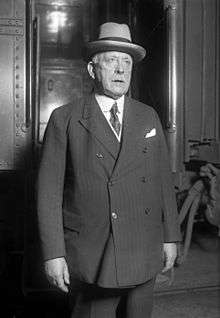James A. Farrell
| James Augustine Farrell, Sr. | |
|---|---|
 Farrell circa 1920 | |
| 2nd President of U.S. Steel | |
|
In office 1911 – April 18, 1932 | |
| Preceded by | Elbert Henry Gary |
| Succeeded by | William A. Irvin |
| Personal details | |
| Born |
February 15, 1863 New Haven, Connecticut |
| Died |
March 28, 1943 (aged 80) Manhattan, New York City |
| Children |
John J. Farrell (businessman) Mrs. Joseph P. Murray Mrs. Luke D. Stapelton James Augustine Farrell, Jr. Mrs. Richard J. Buck |
| Parents |
John Guy Farrell Catherine Whalen |

James Augustine Farrell, Sr. (February 15, 1863 - March 28, 1943) was president of US Steel from 1911 to 1932.[1] A major business figure of his era, Farrell expanded US Steel by a factor of five during his presidency, turning it into America's first billion-dollar company. Farrell was also a champion and early pioneer of export markets, who massively expanded US steel exports to the world with the help of the shipping subsidiary he founded, the Isthmian Steamship Company.
Biography
He was born in New Haven, Connecticut on February 15, 1863 to John Guy Farrell and Catherine Whalen. In 1889 he married Catherine McDermott of Brooklyn, New York and their children include: John J. Farrell, the chairman of the board of the American South African Line; Mrs. Joseph P. Murray; Mrs. Luke D. Stapelton; James Augustine Farrell, Jr. the president of the American South African Line; and Mrs. Richard J. Buck.[1][2]
A classic example of the self-made man, Farrell rose from humble beginnings as a salesman with US Steel and Wire - US Steel's export division - to become the firm's manager by 1899. Under his leadership. US Steel and Wire massively expanded its exports to foreign markets from 200,000 tons per year to 1.5 million tons by 1903.[3]
The son of a ship's captain who was lost at sea, Farrell never lost his interest in maritime affairs and in 1910 established the Isthmian Steamship Company, a subsidiary of US Steel. Farrell believed that if US Steel exported using its own ships instead of leasing cargo space from other shipping companies, it could achieve substantial savings. His assessment proved correct and Isthmian became a highly lucrative subsidiary of the parent firm.
President of US Steel
Cognizant of his obvious talents, the board of US Steel appointed Farrell President of the company in 1911, a position he would be destined to hold for another 22 years until his retirement at the age of 70 in 1932. During his time at the helm, Farrell presided over a five-fold expansion of US Steel, turning it into America's first billion dollar company and the US steel industry's number one player by the mid-1920s. The scale of his achievement can be measured by the fact that in the 74 years since his retirement, US Steel has not significantly increased its share of the US steel industry.
Globalization prophet
Farrell was a pioneer of export markets and believed passionately in the importance of foreign trade. He was particularly keen on increasing trade with Asia. In a 1932 speech, Farrell said:
West of you lies the Orient with the teeming millions of hard-working thrifty people, the great majority of whom, unfortunately are still existing on a standard of life materially below that of some of their neighbors. It is apt to be forgotten...when viewing the current cessation of trade, that the Pacific area is perhaps the most rapidly developing market in the world. Even during the decline of the past two years the interchange of goods between the countries bordering on the Pacific has continued to increase in volume, even though declining in value. All other trade areas have declined in both volume and value.
It is significant to note that this growth of trade was not accompanied by a corresponding increase in population. It was, however, accompanied by a striking development in communication and transportation, the constant companions of commercial progress.[4]
Death
He died on March 28, 1943 in Manhattan, New York City.[1][5] 1,500 people attended the funeral mass at the Church of St. Ignatius Loyola on March 30, 1943 in Manhattan.[6]
Other activities
Farrell was the inaugural chairman of the National Foreign Trade Council, an institution he helped to set up and which he would continue to chair for many years. He also tried to promote interest in foreign trade by supporting institutions such as the School of Foreign Service.[7] Farrell opposed trade unionism and refused to negotiate with unions in the 1919 steel industry strike.[8]
Legacy
Farrell, Pennsylvania is named after him.
References
- 1 2 3 "James Farrell, Former Head of U.S. Steel Dies". Chicago Tribune. March 29, 1943. Retrieved 2016-07-05.
- ↑ "John Farrell, 75, Of Ship Line Dies. His Fleet Helped to Develop U.S. Trade With Africa". New York Times. April 23, 1966.
- ↑ "Foreign Traders". Time magazine. June 6, 1927. Retrieved 2016-07-05.
- ↑ Farrell speech, History of Metropolitan Vancouver website.
- ↑ "J. A. Farrell Dies. U.S. Steel Ex-Head. Laborer at 15. President for 21 Years of World's Largest Industrial Concern. Dean of 'Foreign Trade'. Broke All Shipments Records. Urged Economic Front With Britain to Insure Peace". New York Times. March 29, 1943. Retrieved 2016-07-05.
- ↑ "1,500 Attend Mass For J.A. Farrell. Leaders in Finance, Banking Among Those in Tribute to Dead Steel Official". New York Times. March 31, 1943.
- ↑ "James A. Farrell Announces Plans for Establishment of School of Foreign Service". New York Times. August 22, 1919.
- ↑ Extract from A Catholic Cold War: Edmund A. Walsh, S.J., and the Politics of American Anticommunism.
External links
| Wikimedia Commons has media related to James Augustine Farrell. |
- Farrell speech, History of Metropolitan Vancouver website.